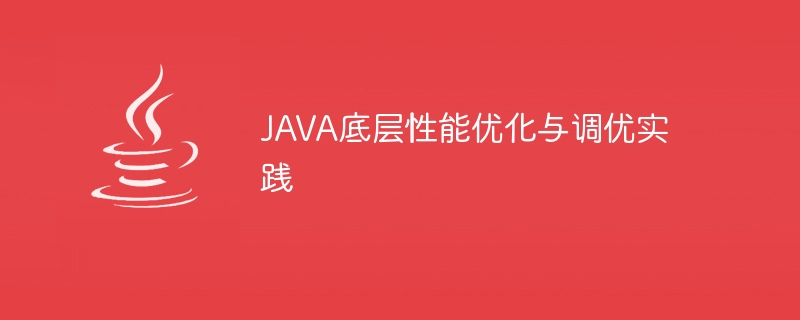

JAVA underlying performance optimization and tuning practice
Abstract: With the rapid development of the Internet, JAVA as a high-performance, high-reliability programming language is widely used Used in various fields. However, due to the existence of the JAVA Virtual Machine (JVM), many developers may not understand the underlying implementation and performance tuning techniques of JAVA. This article will introduce some JAVA underlying performance optimization and tuning practices to help developers better understand and take advantage of JAVA's performance advantages.
1. Understand the JAVA virtual machine
Before learning the underlying performance optimization of JAVA, it is very important to understand the working principle of the JAVA virtual machine. The JAVA virtual machine is the core component of the JAVA running environment and is responsible for converting JAVA bytecode into machine code and executing it. Understanding the working principle of the JAVA virtual machine can help us deeply master the underlying performance optimization techniques of JAVA.
2. Reasonable selection of JVM parameters
When using the JAVA virtual machine, we can optimize performance by setting different JVM parameters. For example, you can adjust the heap memory size, garbage collector selection, JIT compiler options, etc. According to the actual situation and performance requirements of the application, choosing appropriate JVM parameters can significantly improve the performance of the program.
3. Avoid excessive use of locks
Multi-threading is an important feature of JAVA, but excessive use of locks may cause performance problems. In concurrent programming, competition for shared resources should be minimized and excessive lock competition should be avoided. Some alternatives such as lock-free data structures, CAS operations, etc. can be used to reduce the use of locks and improve the concurrency performance of the program.
4. Reduce I/O operations
I/O operations are usually a performance bottleneck of the program. When performing I/O operations, frequent disk reads and writes or network transmissions should be minimized. Batch reading and writing, caching technology, asynchronous operations and other methods can be used to reduce the number of I/O operations and improve program performance.
5. Use efficient algorithms and data structures
In the programming process, rational selection of efficient algorithms and data structures is an important factor in improving program performance. Algorithms and data structures that can reduce time complexity can process large amounts of data faster, reduce CPU usage, and improve program performance.
6. Reasonable use of cache
Cache is one of the common means to improve program performance. In JAVA, you can reduce the number of accesses to databases, networks and other resources by using some caching libraries. Reasonable use of cache can significantly improve the read and write performance of the program.
The above are several practical methods for JAVA underlying performance optimization and tuning. The following is explained through specific code examples:
// 使用StringBuilder代替String进行字符串拼接
String str = "";
for (int i = 0; i < 10000; i++) {
str += i;
}
改进后:
StringBuilder stringBuilder = new StringBuilder();
for (int i = 0; i < 10000; i++) {
stringBuilder.append(i);
}
String str = stringBuilder.toString();
// 使用线程池代替直接创建线程
ExecutorService executorService = Executors.newFixedThreadPool(10);
for (int i = 0; i < 1000; i++) {
final int num = i;
executorService.submit(() -> {
// 线程任务代码
System.out.println("Thread " + num + " is running");
});
}
// 使用高效的排序算法
int[] array = {5, 3, 8, 1, 2, 9, 4};
Arrays.sort(array);
System.out.println(Arrays.toString(array));
// 使用缓存库进行数据缓存
LoadingCache<String, String> cache = CacheBuilder.newBuilder()
.maximumSize(100)
.expireAfterWrite(10, TimeUnit.MINUTES)
.build(new CacheLoader<String, String>() {
@Override
public String load(String key) {
// 数据加载逻辑
return "value";
}
});
String value = cache.get("key");
Conclusion: By rationally selecting JVM parameters and avoiding excessive use of locks, By reducing I/O operations, using efficient algorithms and data structures, and rationally using cache, we can significantly improve the performance of JAVA programs. A deeper understanding of the underlying working principles and performance tuning techniques of JAVA will help us better leverage the performance advantages of the JAVA language and improve the user experience of the application and the stability of the system.
References:
1. In-depth understanding of Java Virtual Machine (Third Edition) by Zheng Haibo, Tsinghua University Press 2021
2. An in-depth explanation of Java performance tuning, actually compiled by Geek Time 2020
The above is the detailed content of JAVA underlying performance optimization and tuning practice. For more information, please follow other related articles on the PHP Chinese website!




